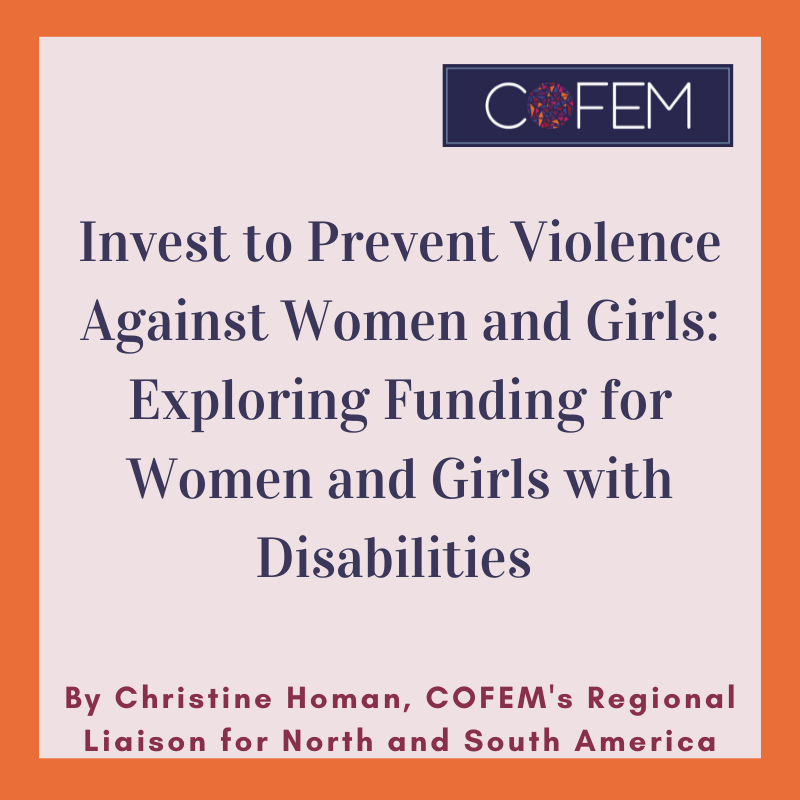Humanitarian crises, climate change and Gender-Based Violence (GBV) have been demonstrated to have an uniquely adverse impact on women and girls with disabilities. While support comes in many forms, it’s clear that in most areas needs are not being met.
One particular area that is rarely discussed is funding. While people are speaking more about GBV than before, the money has not always followed that talk. GBV, Women’s Rights Organizations (WROs) and feminist movements struggle to find sustainable funding in general, as highlighted in the Feminist Handbook on Grantmaking. These challenges are amplified for organizations operating and located at the intersections of multiple systems of oppression. The Black Feminist Fund describes the multitude of ways in which black feminist organizations and movements are underfunded. This seems to be particularly true in the area of GBV against women with disabilities. The Black Feminist Fund highlighted that .09% of funding goes to black women, girls and trans people with disabilities.
Another example of the precarity of funding is that in previous years, a multilateral funder focusing on EVAWG worked to award grants to organizations/programs that focused on women with disabilities, disbursing almost 40% of their grants to programs that address the needs of this population in one year. Outside of that year, grants for programs specifically devoted to this population is closer to 5-8%. Based on the information available on their website, since 2011, roughly 11% of grants have been awarded to programs specifically focused on women and girls with disability. Furthermore, an additional 6% was awarded to programs that identify this population as vulnerable but do not focus exclusively on them. This demonstrates that funding women and girls with disabilities, without a deliberate focus on them, often results in the underfunding of this population.
I also explored examples of Women’s Funds, who are more likely to disburse funding to EVAWG and fund intersectionally. While it’s an imprecise measurement, searching the grantee database of a women’s fund resulted in a few search results when using disability or any variation of it. Out of over 13,000 grants, roughly 150 grants are related to disability. While this rough search likely misses many grants that positively impacted women and girls with disabilities, it does signal that it has not been a consistent focus.
Whether an organization is specifically devoted to women and girls with disabilities, or includes this population as part of a larger mandate, and is a non-profit or an international organization, the funding for this group is hard to come by in the first place and unstable when it arrives. These sorts of inconsistencies in funding make it difficult for organizations and programs to get started in the first place, actual deliver services, and stay afloat. While funding challenges are not unique to non-profits serving women and girls with disabilities, it does have a larger impact on them. This group has unique needs that are not being met and a lack of funding exacerbates that.
To alleviate these challenges, donor organizations and leaders are encouraged to:
- Commit to long term funding. Progress in this area does not happen overnight and inconsistent income hampers progress.
- Understand what the actual needs of an organization are. Far too often donors like to see organizations spend as little as possible on people and resources, without understanding that people and resources are what actually advance a cause. It is important that the population being served is represented in an organization. In this context, employing women and girls with disabilities may require additional resources for reasonable accommodation like translation, text to speech devices, or renovation of office spaces to enhance accessibility. Donors should examine what they fund to better understand if it’s actually addressing an issue. If donors want to truly make an impact, they need to challenge traditional practices and thinking.
- Seek to understand and respond to how disability and gender intersect with other socioeconomic identities,e. understand what the actual needs of women and girls with disabilities are by actively listening to them and recognizing needs will vary greatly depending on context.
- Actively listen to women and girls with disabilities by setting up feedback mechanisms and committing to incorporating their feedback at all stages of funding. This means organizations should include women and girls with disabilities in the decision-making processes for the awarding of grants.
While there is no magic bullet to meeting the needs of this population, if organizations and programs take the time to listen and learn from women and girls with disabilities, and then allocate funds consistently, it will make a huge impact.
By Christine Homan, COFEM Regional Liaison for North and South America.
You can read Christine’s previous blog on Centering Women and Girls with Disabilities in Humanitarian Crisis here and her blog on Feminist Practices to Integrating Women and Girls with Disabilities Humanitarian Response here
